 When Sam and I lived in Tonga for two years, part of his job was to see the Peace Corps volunteers who lived in Samoa as well. On two occasions, when his stay there was for a few weeks, I was lucky enough to go with him! Both times we stayed in downtown Apia (Samoa’s capital), but we were able to see a bit of the main island (Upolu) and some of the Apia sights when he was off-duty. Since Sam’s salary reflected his Peace Corps contractor status, we did almost everything on a budget while there, so with that in mind, here’s a list of eleven things to see and do in Apia, Samoa (and a little history, too).
When Sam and I lived in Tonga for two years, part of his job was to see the Peace Corps volunteers who lived in Samoa as well. On two occasions, when his stay there was for a few weeks, I was lucky enough to go with him! Both times we stayed in downtown Apia (Samoa’s capital), but we were able to see a bit of the main island (Upolu) and some of the Apia sights when he was off-duty. Since Sam’s salary reflected his Peace Corps contractor status, we did almost everything on a budget while there, so with that in mind, here’s a list of eleven things to see and do in Apia, Samoa (and a little history, too).
[Formerly known as Western] Samoa Fast Facts:
Location: Samoa is 102 miles (164 km) northwest of American Samoa, 709 miles (1141 km) northeast of Fiji and about 552 miles (889 km) northeast of Tonga. Because of its closer proximity to the equator, it is considerably warmer than Tonga.
Geography: Samoa consists of eight islets and two main islands: 1) Upolu, where the capital city Apia sits, and its larger neighbor to the west 2) Savaii. Both islands are mountainous, filled with gorgeous waterfalls and rain forests and rivers and beaches and even lava tubes! I have never been to Hawaii, but the impression I have from others is that Samoa is much like Hawaii was perhaps 100 years ago.
Currency: Samoan Tala
Language: Samoan and English
Population: 189,000 (Point of reference: Tonga, which consists of over 170 islands, has a population of 100,000.)
Culture: Samoa demonstrates a unique balance of tradition with modernity. In many ways, Samoa is more westernized than Tonga but their Fa’a Samoa (Samoan communal way of life incorporating three main aspects: family, faith and music) remains very much in tact. Unlike Tonga, here, many women still wear their colorful lava-lava’s (sarongs) instead of modern skirts or pants. In public areas, traditional dance and handicrafts are often conducted. Like Tonga, church-going reigns supreme and every street features at least one magnificent house of worship where the swells of Polynesian singing spill into the streets. Also like Tonga, conservative dress is appreciated, and typical western beach wear should be reserved for actual beach resorts.
Foreign Influences: Before the Second Samoa Civil War in 1898, Samoa included what we now know as Western Samoa and American Samoa, and Great Britain, Germany and the United States were in a squabble as to who had “rights” over the land. In 1899, a Tripartite Convention was reached, whereby Britain withdrew its presence and Samoa was split into two territories: American Samoa and German Samoa. Then, during World War I (late 1914) New Zealand, at the behest of Great Britain, landed in Upolu and seized control from the Germans. After the war, the League of Nations appointed New Zealand as trustee of German Samoa. German Samoa became Western Samoa — a trust territory of New Zealand — until gaining independence in 1962. In 1962, Western Samoa became an independent, parliamentary-democracy-nation while American Samoa remains a territory of the United States. In 1997, Western Samoa changed its name to Samoa. Whew! So, are you even more confused now?
Arrival: Both the airport and the Savaii-Upolu ferry terminal (the ferry terminal to/from American Samoa is located in down town Apia by the marina) are stationed at the western end of Upolu, while the capital city of Apia is situated on the north side, halfway between the western and eastern ends. Even though the distance from the airport to downtown Apia is only about 20 miles, due to South Pacific’s famously ambulating traffic (and the record-breaking plethora of speed bumps), it takes about an hour to reach Apia from the airport!
Where to Stay in Town: Apia has a fair share of guest houses and hotels to choose from, but the creme de la creme remains the famous Aggie Grey’s. And if you can afford to stay here, I’d recommend it at least for a night or two. There are actually now two Aggie Grey’s: one near the airport (where the Survivor television series has been filmed at least twice!) and the original location facing the Apia Harbor. This latter location is the one of which I speak. It oozes South Pacific charm … not to mention garden bungalows where the likes of James Michener and Marlon Brando called it a night.

This place is worth a visit just for the sense of Hollywood-history-meets-South-Pacific alone (and sadly, no, I am not getting paid to shill this place). It also incorporates luscious, landscaped gardens that curl between guest rooms, a gorgeous pool with more tropical flora and bar service, a very nice buffet breakfast (normally included in room rate) with good coffee (more important than the actual breakfast, in my opinion) located in Aggie’s magnificent fale-style dining hall. The hotel also boasts ideal access to Apia’s main attractions.
Where to Stay Elsewhere: If you are through with the sights of downtown Apia and dream of a thatched-roof shack standing over white sands with the steady swoosh of waves just twenty feet away, you have come to the right country. Both the islands of Upolu and Savaii have “resorts” a plenty to choose from with affordable, basic bungalows on the beach. In Upolu, most of these fale-resorts are found on the south end of the island.
Caveat: the word “resort” is loosely used in the South Pacific. Many resorts are closer to backpacker accommodations, which is not a criticism in the least as they certainly offer a laid-back authenticity that higher-end accommodations can not touch, but I thought it worth distinguishing.
What to Do in Apia, Samoa
Samoa is a fantastic place to explore; truly a tropical wonderland that, for the most part, still feels somewhat removed from our modern world. There is internet access and some credit card acceptance here, of course (although almost all facilities transact with cash only), but there remains a true sense of that ideal, South Pacific tradition, too. And most activities cost little — or no — money. What more could a person want?
1. Apia Harbor with Promenade
Directly across from Aggie Grey’s stands the scenic Apia Harbor. If you follow the promenade east from Aggie’s, it leads you to a cute marina with a cluster of restaurants and bars facing bobbing boats. Past this, the promenade ends but the street follows the coast line. If you walk all the way to the end where the dirt road extends past a few houses (where we stayed on one of Sam’s one-month assignments), you’ll often find locals fishing for sea snails and sea urchins.
These divers collect urchins and mollusks, extract the meat, shove them into empty beer bottles and then sell them at the market. If you are brave enough to try this delicacy, you’ll most likely be offered a sample, pre-bottling! I chickened out on the offer and kind of regret it now.
If you follow the promenade west, you’ll pass under banyan trees to the visitors’ center and downtown. On this western route, Apia’s walking tour begins, taking you past historic churches, the old courthouse, a memorial that has something to do with a missionary and potential death-by-cannibalism, and ending at Mulinu’u Peninsula’s sacred burial grounds. In the evenings, the grounds around the visitor center are often filled with locals practicing traditional Samoan dance or chiseling away at a tiki or wooden kava bowl. Definitely worth a visit just to watch. And all along this promenade, as daylight slips away,a sunset burns orange over the water with a glow so beautiful you may not wish to do anything else but just sit and watch.
2. Long Boat Racing
Perhaps the biggest attraction in the area is directly in front of Aggie Greys. On many evenings, traditional wooden (and some fiberglass) long boats spill into the harbor, pulled by a bevvy of enthusiastic Samoan rowers. People crowd along the promenade to watch, but if you like, you can participate, too. Just ask while the next boat comes near the shore; chances are, the crew will be delighted for you to participate.
3. Apia Police Band
Just before 8 am every week day, the Apia Police Band marches from its office (located just west of Aggie Greys, facing the main street and harbor) to the government building. Alas, I never did get my butt out there early enough to witness this myself, but I’ve had others say that it is truly an entertaining experience.
4. Apia Produce and Crafts Market
Following the main road/promenade into town, be sure to visit Apia’s huge outdoor market. To the front, produce and flowers are sold amongst men playing chess and drinking kava. To the back, vendors sell handmade Samoan crafts. Prices on the produce are fixed but I’ve seen people bargain (somewhat modestly) on the crafts before. There’s also a nice, modern(ish) grocery store next to the market, so it’s a good location to stock up on things.
5. Palolo Deep Marine Reserve
This snorkeling reserve is located within easy walking distance of Aggie Grey’s. If you follow the promenade east and pass the marina, the promenade ends but a road continues until you reach a shady parking area with a ramshackle sign.
Pass under the banyan trees until you reach the tiny kiosk to pay your $3 Tala entrance fee (you can rent a snorkel and mask here, too if you don’t have one). Once inside, there are a few picnicking areas, but mostly you are faced with water. It may not look like much, but once you’ve swum out about a hundred yards, the ocean world opens to you. Coral, fish, eels, sponges, starfish, sea worms, anemones and more lead you to a “deep hole” where the floor falls so steeply that the bottom can not be seen! Be aware of your tide chart, though. The water depth can get shallow in a hurry and (as Sam has discovered) can strand you in a bed of coral if you happen to be between shore and the deep reserve. Hours: 8 am to 6 Monday through Sunday.

6. Fia Fia Night (Fire Dance)
If you can afford it, you should catch a Fia Fia show, where male Samoan dancers done vegetation, slick themselves down with coconut oil and then stomp up a frenzy to the beat of drums and the twirling of fire hoops. Sound crazy? It is. Aggie’s has the best-known show on the island (every Wednesday; show and buffet dinner inclusive), but there is a cheaper option downtown at one of the restaurants right across the street from the marina (see item 1).
7. Ride the Public Bus
Bus rides in Apia run around two Tala a trip and the end destination is typically listed on the front or the back of the bus. If you are in town, it is worth hoping on for at least for a few stops, just for the experience. The more packed the bus is, and the louder the music, the better! These buses each have their own crazy theme going on, too, with elaborate paintings along the sides and back. I still kick myself for not being quick enough with the camera when one especially boisterous bus passed me one day, and on its back was a painting of Mickey Mouse standing in front of what I presume to be Disneyland, with the caption “The Sum of all Fears.”
8. Zumba
I think this experience actually blew my mind. There is Zumba, and then there is Apia Zumba, held at the local gym downtown. It is nothing short of spectacular. Here, you will meet men and women from every walk of life. You’ll meet locals and tourists, clergy and club owners. Everyone participates … because the instructor is freaking amazing. If you can, GO!
9. Robert Louis Stevenson Museum
For reals, folks. The Robert Louis Stevenson. Treasure Island! Kidnapped! Strange Case of Dr. Jekyll and Mr. Hyde!
It is here in 1890, in the hills of Vailima, midway between the north and south sides of Apia, that the ailing Tusitala (Samoan name for Robert Louis Stevenson, which means “Teller of Tales”) purchased 400 acres and built an estate. Four years later, he passed away and was buried on Mount Vaea overlooking his beloved Vailima estate. Now, you can tour his home and view Fanny’s bedroom and where Robert Louis Stevenson convelesced, see original sketches and paintings done by Fanny’s daughter, hear humorous anecdotes of his time in Samoa and hike the lush jungle-trek to his gravestone where both he and his wife Fanny(who passed away ten years later) are laid to rest.
The epigraph RLS wrote for Fanny touched me the most, I think.
Website: http://robert-louis-stevenson.org/109-samoa-museum-western-samoa/
Admission: $15 Tala (adult) (UPDATE: This price was current at the time this post was originally published in 2013. Please contact the museum for current admission information.)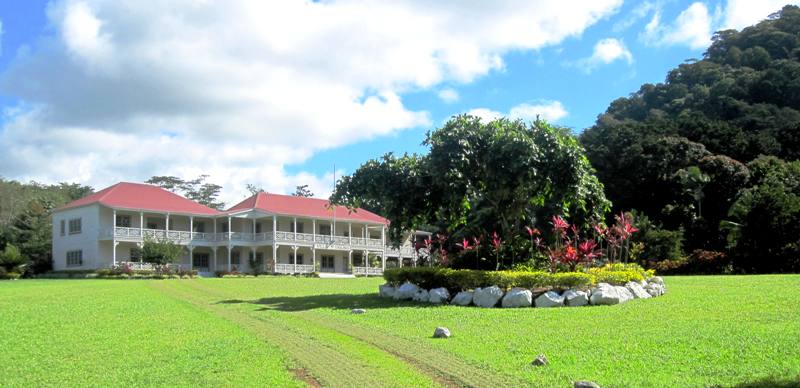

10. Papase’ea Sliding Rocks
Six kilometers (3.6 miles) out of town lies a tort-riddled paradise. Where else in the world could one pay a modest fee to potentially drown while breaking both legs and fracturing one’s tail bone? That said, Sam and I had so much fun … largely because we walked away from the experience, for the most part, unharmed.
What is this place?
It is a sequence of natural rock slides down a waterfall. Some guidebooks refer to one 5 meter slide in particular, but when we went, the locals showed us several “slides” to experience.
I will say this: we did have tons of fun. I will also say this: I do think there is significant potential to seriously injure ones self, especially as the water can propel you down at various, unpredictable angles where your tail bone may or may not hit the rocks pretty hard. Safer options include watching others defy death while serenely splashing about in the fresh water pools below.
Getting there: The easiest way is to have a taxi bring you, but be sure you agree ahead of time on the price and on the taxi bringing you back. The sliding rocks are a bit removed from town, so you’ll be stuck if no transport is pre-arranged.
11. And last but not least: Island Tour!
Hotels and guest houses offer a variety of island tours, but if you are like Sam and me, then you will want to arrange your own. You really have two do-it-yourself options: rent a car or hire a taxi for the day.
The trouble with renting a car is that you may not find the location you are looking for as some sites are mislabeled, not labeled, or otherwise inaccessible due to any variety of reasons. So, if you are new to Upolu, I would suggest hiring a taxi. But first, ask either your hotel or the visitor’s center for the latest information on taxi fares.
The Samoan government maintains a list of fare rates to various locations, and if you do not know what these are, chances are your very friendly taxi driver will reap the benefit. Also, when you hire a taxi driver, be aware that he (I have yet to see a female taxi driver in Samoa) will most likely try to steer you towards certain activities. You may or may not want to drink coconuts with his friend, drink kava with his uncle and attend an eco-farm run by his cousin, all for modest entrance fees. Either way, just be prepared.
If you do decide to rent a car and drive yourself, be ready for unexpected road conditions, like a river crossing or a road block caused by dilapidated cars on fire. We encountered both on a Sunday drive. Regarding the latter, since there is only one road going north to south in the middle of the Upolu, we decided to wait for the fire truck to arrive and clear the road (the person in the car was unhurt). While we were waiting, we struck up a conversation with two visiting Kiwis of Samoan descent. “Today is so weird,” one of them remarked while staring at the smoking car. “Maybe this is another omen because earlier, we saw a white owl!”
His friend nodded solemnly in agreement, his eyes wide with wonder.
“Oh,” I said, confused at the significance of a white owl, and then there was silence for a moment or two. Finally, I said, “Sorry, but what does a white owl mean?’
To which the man replied, “I don’t know, but a white owl has to mean something!”
It’s little things like that that make waiting on the side of the street for an hour worth one’s while!
So where to go on your island tour? This is where the the grandeur of Upolu becomes apparent. So many amazing locations! This website provides a helpful map as well as information on the sights in Samoa, but here are the highlights we personally experienced:
Le Mafa Pass
Snaking into the hills east of Apia is the gorgeous Le Mafa Pass. At this vantage point, you can see the verdant lands of Upolu spread below. It really is beautiful and, after the flat, dusty streets of Apia, provides a perspective of how big and green and diverse this island is. (Entrance: free)

Sopoaga Falls
Following the road south of Le Mafa Pass, several waterfalls await. We stopped at Sopoaga Falls. The viewing area charged $5 Tala per adult, and even though it definitely has a tourist-trap-feel about it, it is a nice spot to take in the view, as well as gain some education on the local plant life, such as the kava pepper plant, whose roots and branches are used in the South Pacific’s popular kava drink. You may also be given a demonstration on how to properly husk a coconut!
Lalomanu Beach
At the far south-eastern end of Upolu, Lalomanu Beach looks right out of a post card.
The snorkeling here is pretty decent, the scenery unparalleled and the few beach-side restaurants at hand offer tasty fish and chips as well as Samoa’s famous Vailima beer. It is this side of the island that a tsunami hit in 2009, wiping out entire villages and killing at least 79 people.
Our taxi driver told us that part the problem was, before then, the villagers had never seen a tsunami. The Samoan name for tsunami loosely translates to “fire water” or (“fire from the sea”) so when the disaster hit and villagers were alerted to evacuate, many thought they had nothing to fear from a storm that brought fire over the sea. They remained in their homes straddling the coastline, never imagining that fire water would rise up and wash their homes and families away.
The resorts and restaurants located here are run by families from these villages, so your money goes toward helping rehabilitate this area and the people affected.
Feed Turtles at the Turtle Sanctuary
Following the main road from town to the airport, a pond on the left side of the road shelters turtles that, purportedly, are reclaimed from capture or otherwise rehabilitated. I didn’t see any information on the process, so I don’t know if this place is indeed a sanctuary, but in any case, it’s a popular place for locals to go and feed the turtles with bread or papaya leaves. Just park your car at the parking lot by the pond, bring your food stash and in you go.
Sua Trench
Located on the south end of Upolu, west of Lalomanu Beach in the village of Lotofaga (and within the same grounds as some scenic, coastal blow-holes) is the Sua Trench. Admission is $15 Tala a person, and, I think, totally worth it. If you are lucky enough to arrive as we did when no one else is around, this place will make you feel like you’ve just landed in the middle of a science fiction novel. The word surreal is not misused here. Because it is. Surreal. A lone ladder leads into the trench, where you swim in a pool of aqua marine. It takes some getting used to the feel of the tide pulling the water in and out (the ocean is just a 100 feet or so away). It is said that one can swim under the limestone cave here into the sea beyond, but I did not try this.
That scratches the surface of what to do in city of Apia and the island of Upolu upon which it sits. There are caves and waterfalls and beaches we never had a chance to explore.
And then of course, there is Savaii just a ferry ride away, where life gets even greener, the pace even slower, and the prettiest little villages I’ve ever seen dot the road circling the island.





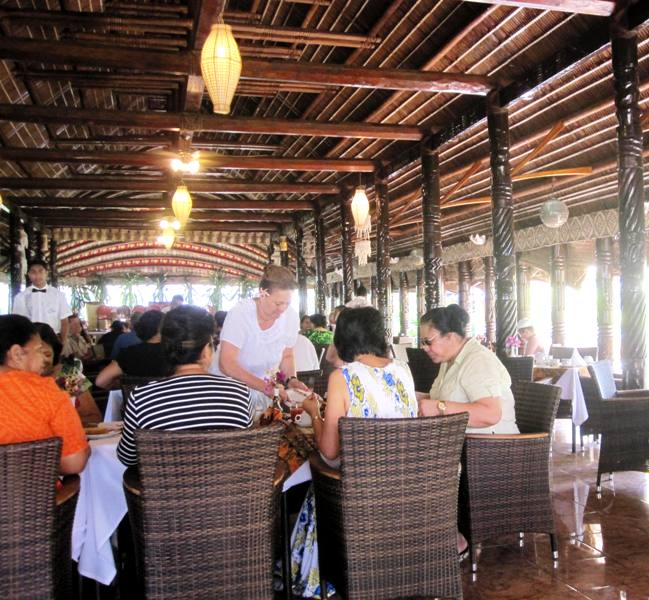












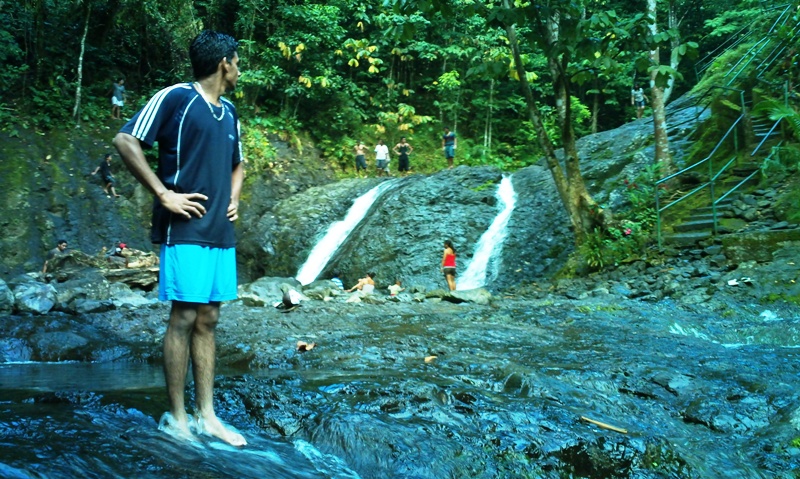
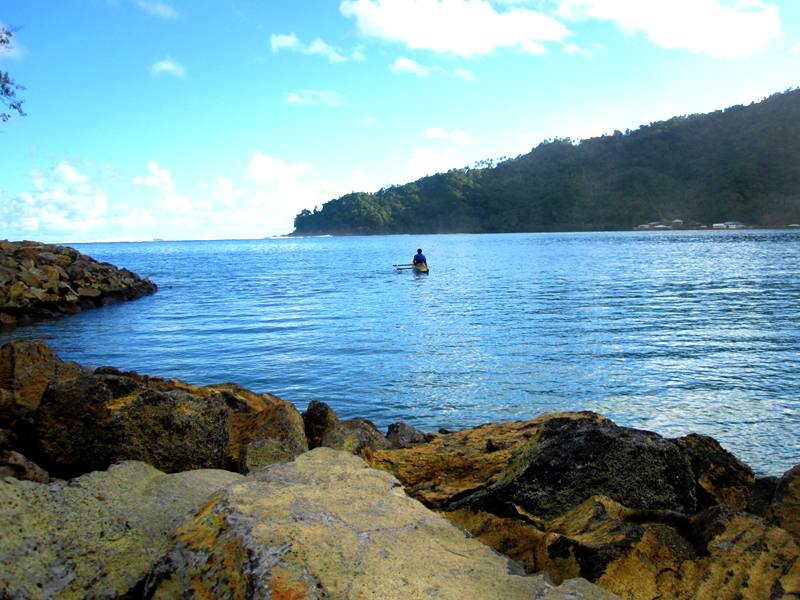





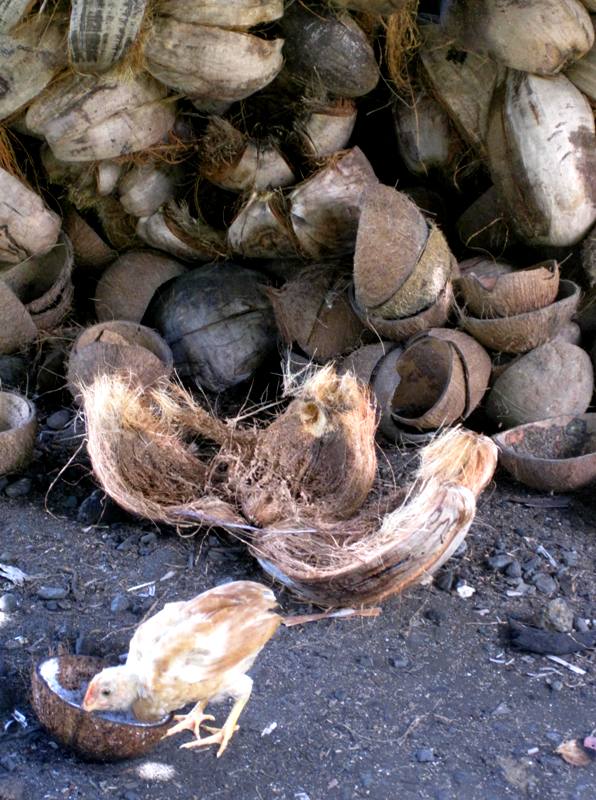








I know you through your mother-in-law. We met at the senior exercise class several years ago. She shared your book with me. I then, purchased it for my granddaughter and began to research you. What lovely photos you have provided on your sight.
Hi Miss Cendy,
I am sorry for the delayed response. Sam and I have been traveling and I did not have access to internet for much of the time.
Thank you so much for purchasing my book and for visiting Tonga Time! Thanks, too for your kind comments. I hope your granddaughter likes Liberty Frye and I would love to hear her thoughts on it when she is done.
Thanks again and Merry Christmas to you and your family.
Jesse
Congratulations on a beautifully constructed site. Your photohgraphy is wonderful and your enthusiasm shines through.
We have been twice to Samoa and are about to go back. I am writing a book on R L Stevenson and Samoa, Like RLS, I am Scottish. We will be staying in Apia, but I mean to visit some of the villages this time, especially Malie, the traditional residence of the ‘king’ of Samoa. Any knowledge on this place you can share would be much appreciated. I presume one of buses will go there.
Good wishes for 2016
Hi Joe,
Thanks for your kind comments. And your project on Robert Louis Stevenson sounds exciting! Please let me know when it is published.
Unfortunately, we don’t recall anything about the village of Malie, so I’m no help there. The hotel where you are staying should be able to tell you if and when a public bus goes, and of course, you can always rent a car or catch a taxi. In any case, I am jealous that you get to spend some time in Samoa. Have a Vailima for me!
Good luck and Happy New Year!
WOW ! What a list, I love that you guys have shared the history of Samoa as well.
We recently shared a similar post that you guys might like !
http://www.levasaresort.com/blog/things-to-do-in-samoa
Does anyone have the name of a driver we could hire for a private tour ?